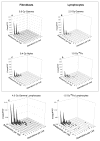Chromosome damage in human cells by γ rays, α particles and heavy ions: track interactions in basic dose-response relationships
- PMID: 23198992
- PMCID: PMC3580060
- DOI: 10.1667/RR3089.1
Chromosome damage in human cells by γ rays, α particles and heavy ions: track interactions in basic dose-response relationships
Abstract
We irradiated normal human lymphocytes and fibroblasts with (137)Cs γ rays, 3.5 MeV α particles and 1 GeV/amu (56)Fe ions and measured the subsequent formation of chromosome-type aberrations by mFISH at the first mitosis following irradiation. This was done for the purposes of characterizing the shape of dose-response relationships and determining the frequency distribution of various aberration types with respect to the parameters of dose, radiation quality and cell type. Salient results and conclusions include the following. For low-LET γ rays, lymphocytes showed a more robust dose response for overall damage and a higher degree of upward curvature compared to fibroblasts. For both sources of high-LET radiation, and for both cell types, the response for simple and complex exchanges was linear with dose. Independent of all three parameters considered, the most likely damage outcome was the formation of a simple exchange event involving two breaks. However, in terms of the breakpoints making up exchange events, the majority of damage registered following HZE particle irradiation was due to complex aberrations involving multiple chromosomes. This adds a decidedly nonlinear component to the overall breakpoint response, giving it a significant degree of positive curvature, which we interpret as being due to interaction between ionizations of the primary HZE particle track and long-range δ rays produced by other nearby tracks. While such track interaction had been previously theorized, to the best of our knowledge, it has never been demonstrated experimentally.
Figures






References
-
- Zirkle RE. The radiobiological importance of linear energy transfer. In: Hollaender A, editor. Radiation biology. New York: McGraw-Hill; 1954. pp. 315–50.
-
- Lea DE, Catcheside DG. The mechanism of the induction by radiation of chromosome aberrations in Tradescantia. J Genet. 1942;44:216–45.
-
- Lea DE. Actions of radiations on living cells. Cambridge: Cambridge University Press; 1955.
-
- Savage JRK. A brief survey of aberration origin theories. Mutat Res. 1998;404:134–47. - PubMed
-
- Kellerer AM, Rossi HH. The theory of dual radiation action. Curr Top Radiat Res Q. 1972;8:85–158.
Publication types
MeSH terms
Grants and funding
LinkOut - more resources
Full Text Sources

